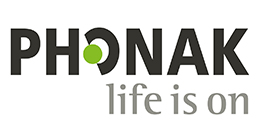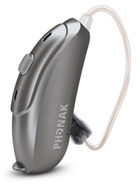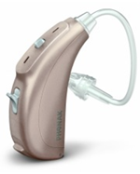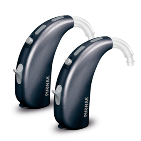Pure Tone Audiometry
What is pure tone audiometry?
Pure tone audiometry is a hearing test used to determine the presence or absence of hearing loss. If hearing loss is present, the audiologist will be able to determine both type and degree of hearing loss.
What should I expect?
You will be seated in a soundproof room, with headphones on or in (we use insert earphones as standard) your ears, and a bone conduction headband on your head. Your audiologist will be seated on the outside of the sound booth and manipulate the audiometry equipment while testing your hearing.
There are two parts to this test.
- Your audiologist will first test to see if you are able to hear a variety of different pitches. You will be asked to push a button or raise your hand when you hear the different tones.
- This part of the test examines air conduction and bone conduction. Both the headphones for air conduction testing and the headband with the oscillator are placed behind your ear for bone conduction testing.
Your audiologist will compare the results of the two types of conduction to determine which part of your auditory system is responsible for the loss.
How long does the test take?
20 to 25 minutes.
How will I receive my results?
Your audiologist will review your test results with you when your testing is completed.
Depending on your result, your audiologist will recommend further testing, an otology consult, or discuss the possibility of using hearing aid technology to improve your hearing.
Speech Audiometry
What is speech audiometry?
There are 2 different speech tests that will be completed. One will determine how softly you are able to hear words and the other will measure how clearly you are able to understand words.
What should I expect?
You will be seated in the sound booth and will be wearing headphones.
- Your audiologist will ask you to repeat a list of words to determine your Speech Reception Threshold (SRT) or how soft you were able to repeat common words.
- You audiologist will measure Speech Discrimination or Word Recognition ability. The audiologist will be either saying words to you or you will be listening to a CD recording. You will be asked to repeat the words. The audiologist will be measuring your clarity or ability to understand speech.
How long does the test take?
5-10 minutes
How will I receive my results?
The audiologist will share your test results with you at the completion of testing. Speech Discrimination ability is typically measured as a percentage score.
Tympanometry
What is Tympanometry?
Tympanometry provides a way, along with a physical exam, for doctors to diagnose and monitor problems with the middle ear. It can help with diagnosing disorders that can lead to hearing loss, especially in children.
The test measures your ear’s response to both sound and pressure. The results are recorded on a graph called a “tympanogram.”
The test can tell the doctor if you have:
- fluid in your middle ear
- otitis media (ear infection)
- a perforation (tear) in the eardrum
- a problem with the Eustachian tube (tube that links the upper part of the throat and nose with the middle ear)
To chronicle how much fluid a child has in their middle ear over time, typanometry can be performed every few weeks for several months.
How is Tympanometry Performed?
Before the test, your doctor may look inside your ear canal with a light to make sure there is no earwax or a foreign object obstructing your eardrum. Next, a probe-type device is placed into your ear canal. It may feel a little uncomfortable, and you will hear loud tones as the device begins to take measurements. This test changes the air pressure in your ear, making the eardrum move back and forth. The test measures the results on graphs called tympanograms.
You won’t be able to move, speak, or swallow during the test or it may give an incorrect result. If your child is having tympanometry, they may need to be shown how the test is done using a doll so they can prepare for the loud noises and practice being still beforehand. The test takes about two minutes for both ears. Anyone from infants to adults can have tympanometry, which usually takes place in a doctor’s office.
Interpreting the Results of Your Test
Normal Results:
When results are normal, there is no fluid present. Normal pressure inside the middle ear can vary between +50 to -150 decapascals. Decapascals (or daPa) are a measurement of air pressure. In a normal test result, the eardrum looks smooth. A normal tympanogram also shows normal pressure in the middle ear with normal movement of the eardrum and the conduction bones—these are bones that aid in hearing.
Abnormal Results:
Tympanograms that show an abnormal result may reveal:
- fluid in the middle ear
- perforation of the tympanic membrane (tissue that separates the middle from the outer ear)
- scarring of the tympanic membrane (from frequent previous ear infections)
- middle ear pressure beyond the normal range
- tumors in the middle ear
- earwax blocking the eardrum
- lack of contact between the conduction bones of the middle ear
- perforated eardrum





 Developed to satisfy people, who desire and expect nothing but the best. These hearing aids optimally support understanding in even the most difficult listening situations including those with high levels of background noise
Developed to satisfy people, who desire and expect nothing but the best. These hearing aids optimally support understanding in even the most difficult listening situations including those with high levels of background noise
 Developed to satisfy people, who desire and expect nothing but the best. These hearing aids optimally support understanding in even the most difficult listening situations including those with high levels of background noise
Developed to satisfy people, who desire and expect nothing but the best. These hearing aids optimally support understanding in even the most difficult listening situations including those with high levels of background noise
 Developed to satisfy people, who desire and expect nothing but the best. These hearing aids optimally support understanding in even the most difficult listening situations including those with high levels of background noise
Developed to satisfy people, who desire and expect nothing but the best. These hearing aids optimally support understanding in even the most difficult listening situations including those with high levels of background noise
 Developed to satisfy people, who desire and expect nothing but the best. These hearing aids optimally support understanding in even the most difficult listening situations including those with high levels of background noise
Developed to satisfy people, who desire and expect nothing but the best. These hearing aids optimally support understanding in even the most difficult listening situations including those with high levels of background noise
 Developed to satisfy people, who desire and expect nothing but the best. These hearing aids optimally support understanding in even the most difficult listening situations including those with high levels of background noise
Developed to satisfy people, who desire and expect nothing but the best. These hearing aids optimally support understanding in even the most difficult listening situations including those with high levels of background noise